This was published 5 years ago
Lucerne, Switzerland: The most picturesque town on Earth
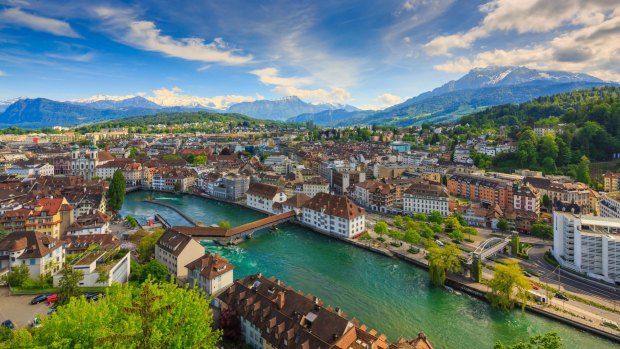
The Reuss River splits the Swiss city of Lucerne in half.Credit: Shutterstock
In most countries, Lake Sempach would be a magnet for poets and painters, tour buses and selfie sticks. About seven-and-a-half kilometres long and three kilometres wide, it's edged by pastoral fields and tree-carpeted hills, snow-dusted peaks and cute hamlets clustered around spired churches. On a sunny day – like today – it's a spellbinding, mirror-like spectacle. Alas, Switzerland isn't like most countries. And Sempachersee (as the lake is known here) is just one of hundreds of beautiful bodies of water that sprinkle an alpine nation so naturally photogenic you'll never need to waste time twiddling with those funky Insta filters.
We breeze nonchalantly by Sempachersee as we travel by coach to Lucerne, a Swiss city set around a lake that's even larger, more iconic and gob-smacking than this one. We're on a shore excursion from Basel, one of the ports on our Jewels of the Rhine voyage with Crystal – an all-inclusive 14-night trip along one of Europe's most storied waterways, which originates, fed by glaciers, in the Swiss Alps. After arriving in Lucerne, which hugs the western banks of Lake Lucerne, my eyes drift over the sprawling, bluey-green expanse of water and towards those distant alpine mountains, which still sport a healthy coating of white powder despite the unseasonably warm spring (it's mid-May and already 28 degrees).
Tons of snow have already melted, however, and the Reuss River, which flows through the lake and re-emerges to split the city of Lucerne in half, is a gushing presence. Water churns beneath our feet as we tread the boardwalks of the Kapellbrucke (Chapel Bridge), one of several postcard-perfect sights in a city that is the sixth largest in Switzerland by population (80,000), but arguably the most aesthetically-pleasing of the lot. Distinguished by its red-tiled roof and adjoining water tower (and one-time prison and torture chamber), Chapel Bridge dates back to 1333, but has been reconstructed many times, most notably after a devastating 1993 fire – one of many blazes to have ripped through Lucerne down the centuries.
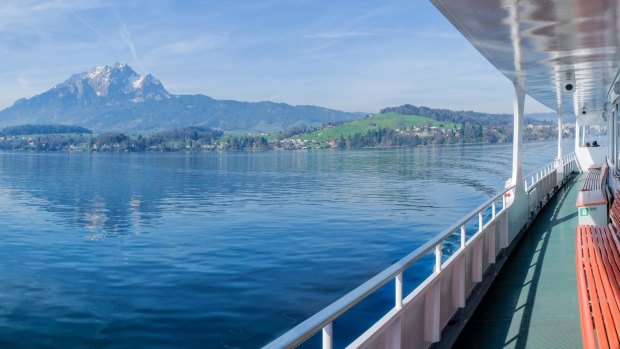
A ferry on lake Lucerne.Credit: SHUTTERSTOCK
The bridge is still noticeably charred in parts, especially by its pictorial panels, which hang under the eaves and illustrate Swiss and local history. This is one of half-a-dozen or so bridges that connect the newer (but still ancient) part of Lucerne with the Aldtstadt (Old Town), a labyrinth of narrow, winding streets, thigh-straining stairways and quaint squares. With our guide, Anna Maria, leading the way, we admire dozens of charming old buildings from the late Middle Ages and Renaissance eras, when Lucerne flourished as a trading and transit post. Merchants would pitch up here after navigating Lake Lucerne with their goods loaded onto barges, some having crossed the St Gotthard Pass, a fear-inducing mountain pass that historically split southern and northern Europe.
While some Aldtstadt landmarks proved fire-resilient and still flaunt half-timbered features, most are made purely of stone and prettified by colourful paint, frescoes and polychromatic tiled roofs. We pause at Weinmarkt, a square that has witnessed many a festival and passion play, and is framed by decorative old guildhouses. Anna Maria points out a sculpture of a meat cleaver draped outside the former butchers' guild, while on the old wine market building, there's a mural of Jesus turning water into wine. We're left to our own devices for lunch, and there are oodles of enticing choices, with al fresco cafes and restaurants lining the Reuss, plus shaded spots where local workers and students picnic on baguettes, their bicycles parked at their feet.
Having over-indulged on my cruise so far (Crystal is justifiably lauded for its gourmet cuisine), I skip lunch and clamber up to the Musegg wall which, like the Chapel Bridge, was part of the 14th-century fortifications constructed to defend Lucerne. There's a remarkably well-preserved stretch punctuated with chunky watch-towers that's open to the public. Looking north as I meander along these ramparts, I glance down at playing fields and meadows that have a countryside aura with the scent of grass and manure, the trilling of birds and the sight of cattle munching and idling (there's also a mini-farm and microbrewery nearby).
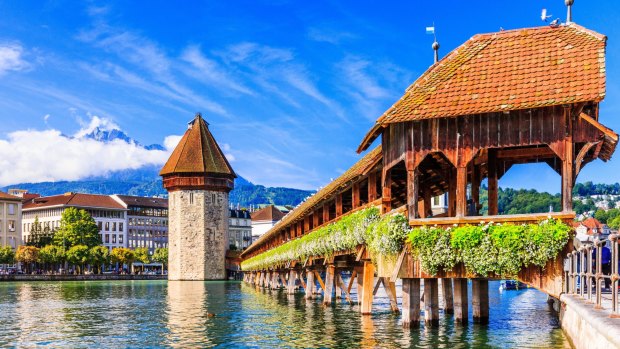
The historic city centre with its famous Chapel Bridge.Credit: SHUTTERSTOCK
Turn around and enchanting views of Lucerne and the lake await. Leaving the Musegg wall behind, I trot back down into the Aldstadt, passing souvenir shops and luxury boutiques (some bedecked with Chinese lettering thanks to all the tourists from the Far East). My group is queuing on the lakeside promenade to board MS Saphir. It's a 210-capacity "Panorama-Yacht" and a sleek modern contrast to the paddle-steamers that have traditionally serviced the lake. Seated on the canopied open-air deck as we cruise away from Lucerne, I listen to the audio guide, which unfurls intriguing local facts and folklore, interspersed with folk tunes and classical music. Johannes Brahms and Richard Wagner were among the famous figures to be seduced by Lake Lucerne as it became a fashionable destination in the 19th century.
Wagner lived by the lake with his mistress, and future second wife, Cosima, and composed one of his major works, Siegfried Idyll, here on his grand piano. Mark Twain, Thomas Mann and Leo Tolstoy were some of the writers inspired by the lake, while celebrated royal visitors included Russian czars, the Shah of Persia, the King of Siam and Queen Victoria. As well-heeled guests flocked to Lucerne, opulent Belle Epoque-era hotels and casinos sprang up, and they're still here, lording by the water. We also spot, on our cruise, contemporary hill-side apartments, rustic chalets and castle-like villas and mansions – some commissioned by wealthy industrialists and merchants, who made their fortunes transporting exotic wares, from as far afield as China and Brazil, across the lake.
Beneath one grand property, perched on a promontory, there's a statue of Jesus with his arms spread out and a little chapel that's apparently a popular wedding venue for Japanese. Though it's lovely to savour the lake at this gentle pace, you can get active, too. We see people swimming off a lido beach, a couple canoeing, and match-stick figures hiking in the peaks and atop the sheer, luxuriant cliffs that dwarf every sightseeing vessel. Among the mountains towering above is the craggy Pilatus Massif, which medieval storytellers claimed was home to dragons and the ghost of Pontius Pilate (some accounts reckoned he was buried up there). More likely is that the name derives from the Latin word "pileatus" , meaning cloud capped – as Pilatus' 2128m summit is, ever so slightly, today.
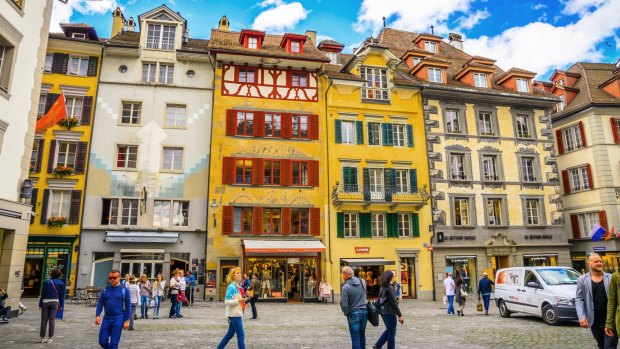
The pretty streets of Lucerne.Credit: SHUTTERSTOCK
Queen Victoria scaled the peak on horseback in 1868, but since 1889, travellers have been able to take the world's steepest cogwheel railway, which chugs up at a maximum gradient of 48 per cent. As we cruise back towards Lucerne, we come to the heart of a lake that has a rather unconventional shape, with its series of bends and four spindly arms. German and French-speaking Swiss also know this as Vierwaldstattersee (which roughly translates to Lake of the Four Forested Settlements) and Lac des Quatre Cantons (Lake of the Four Cantons). In AD1291, the country's first confederation was founded on the lake-side Rutli meadow, comprising the three original neighbouring cantons of Uri, Schwyz and Unterwalden. Four decades later, Lucerne, joined the club. Whatever you prefer to call this lake, it should be on every Swiss travel itinerary.
As the New Yorker sitting near me on Saphir says (more than once): "Oh my gawd. It's just gorgeous."
Steve McKenna was a guest of Crystal River Cruises.
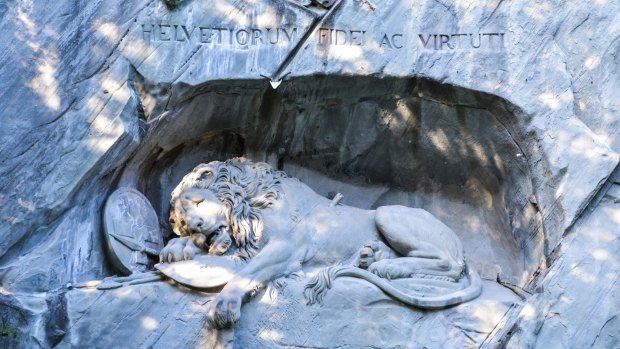
The Dying Lion of Lucerne monument.Credit: Shutterstock
TRIP NOTES
MORE
CRUISE
Lovely Lucerne and the Lake is one of several complimentary shore excursions that can be enjoyed on a Rhine voyage with Crystal River Cruises. Crystal offers seven-, 10- and 14-night cruises between Amsterdam and Basel (with some cruises departing and finishing in Frankfurt) aboard its state-of-the-art vessels, Crystal Bach and Crystal Debussy. Priced from US$3490 ($4690) per person. See crystalcruises.com
Sign up for the Traveller Deals newsletter
Get exclusive travel deals delivered straight to your inbox. Sign up now.